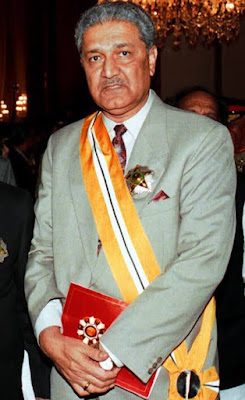The man called "Dr. AQ Khan"
Two letters have changed the course of history. Albert Einstein’s famous first letter to President Franklin Roosevelt dated August 2, 1939 and Dr A.Q. Khan's second letter in 1974 to Prime Minister Bhutto who remarked that ‘the man makes sense’.
In the state of Bhopal, India, the headmaster of a local school, Abdul Ghafoor, chose to retire in 1935. The following year, in April, he and wife, Zulekha, had their yo ngest son— they named him Abdul Qadeer Khan, famously known as A. Q. Khan. A decade later, during the traumatic years that surrounded partition, Bhopal was the scene of intense Hindu-Muslim riots. Abdul Ghafoor’s family was profoundly affected by the prejudices of the Hindus and decided to immigrate to Pakistan in August 1952, and settled in Karachi.
In 1953, the 17 year old Abdul Qadeer Khan received admission in D. J. Sindh Govt. Science College in Karachi. His friends characterized him as a decent man who prayed regularly, but avoided indulging in religious discussions. After earning a B.S. from Karachi University, he stayed in the city for three years to serve as an inspector of weights and measures, and then left for West Berlin. A. Q. Khan traveled across Europe, earning degrees along the way— an M.S. from the Technological University of Delft, Holland, and a Ph.D. in copper metallurgy from Catholic University of Leuven, Belgium, under the supervision of Professor Martin Brabers. A.Q. Khan pursued a higher education, Pakistan underwent the tragic events of 1971. This historical episode of the Fall of Dhaka not only changed the map of the region but also influenced Dr A.Q. Khan in particular, who recalled personal humiliation and forced migration to Pakistan. When India conducted its first nuclear test in 1974, he was well settled in Holland with his wife, Hendrina (Henny) Khan, and two daughters— Ayesha and Dina.
The Indian nuclear test transformed both the security landscape in the region and the “man from Pakistan.”
A.Q. Khan’s dissertation on exotic metals and their ability to withstand high rates of deformation made him a prime candidate for metallurgy -related jobs. He accepted a job offer at Fysisch Dynamisch Onderzoek (FDO), a subsidiary of Vernidge Machine Fabrieken (VMF), which worked closely with Ultra-Centrifuge Nederland (UCN), a member of the Uranium Enrichment Consortium (URENCO). As an employee at the URENCO plant in Almelo, Netherlands, he gained crucial knowledge of centrifuge-based enrichment operations. Fluent in German, French and English, he was often asked by his managers to translate German reports on centrifuge technologies.
Following India’s nuclear test, in August 1974, he wrote a letter to Prime Minister Bhutto, volunteering his expertise in gas centrifuge technologies to the country. The letter went seemingly unnoticed and probably was treated as another “nut case.”
A. Q. Khan persisted, however, and sent another letter on September 17, 1974; this time through the Pakistani ambassador in Holland, explaining the significance of highly enriched uranium (HEU) as an alternative to the plutonium path to the bomb. Finally, the letter caught the attention of the prime minister, who remarked that the “man makes sense.”
Within Pakistani circles, Khan’s letter to Bhutto is considered analogous to Albert Einstein famous first letter to President Franklin Roosevelt dated August 2, 1939.
Dr A.Q. Khan and his team's effort in the next two decades paid dividends and Pakistan became a nuclear power in 1998.
May Allah bless him with highest ranks in Jannah.
Reference:
‘Eating Grass The Making of the Pakistani Bomb’ by Feroz Hassan Khan.



Comments
Post a Comment